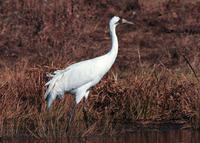WHOOPING CRANE

Bob Gress
The Whooping Crane is the tallest (5 ft.) North American bird and has a 7-8 foot wing spread. Adults are white with black wing tips and a red face. Young may be whitish gray with rusty wash color on their head and neck and scattered reddish brown feathers over their back and sides.
Whooping Cranes are regular spring and fall transients through Kansas, generally passing through the marked corridor in March-April and October-November. Occurrences outside the marked corridor have been infrequent but as crane populations increase, such sightings may become more frequent. Preferred resting areas are wetlands in level to moderately rolling terrain away from human activity where low, sparse vegetation permits ease of movement and an open view. During migration, cranes feed on grain, frogs, crayfish, grasshoppers, fish, crickets, spiders, and aquatic plants.

The Whooping Crane is the tallest (5 ft.) North American bird and has a 7-8 foot wing spread. Adults are white with black wing tips and a red face. Young may be whitish gray with rusty wash color on their head and neck and scattered reddish brown feathers over their back and sides.
Whooping Cranes are protected by the Kansas Nongame and Endangered Species Conservation Act, the Federal Endangered Species Act, and state and federal regulations applicable to those acts. Any time an eligible project is proposed that will impact the species’ preferred habitats within its probable range, the project sponsor must contact the Ecological Services Section, Kansas Department of Wildlife, Parks and Tourism, 512 SE 25th Ave., Pratt, Kansas 67124-8174. Department personnel can then advise the project sponsor on permit requirements under Kansas’ statutes. Sponsors of projects impacting
critical Whooping Crane habitats must also contact the Endangered Species Office, U.S. Fish and Wildlife Service, 315 Houston Street, Suite E, Manhattan, Kansas 66502.
As defined by Kansas Administrative Regulations, critical habitats include those areas documented as currently supporting self-sustaining population(s) of any threatened or endangered species of wildlife as well as those areas determined by the Kansas Department of Wildlife, Parks and Tourism to be essential for the conservation of any threatened or endangered species of wildlife.
Currently, the following areas are designated critical for Whooping Cranes:
(1) All lands and waters within Cheyenne Bottoms Wildlife Area located east of U.S. Highway 281 and north of U.S. Highway 56 in Barton County.
(2) All lands and waters within Quivira National Wildlife Refuge in Stafford, Reno, and Rice counties.
The U.S. Fish and Wildlife Service has authority to designate areas of critical habitat for federally listed endangered species and has designated the following in Kansas:
Areas of land, water, and airspace with the following components: (1) Quivira National Wildlife Refuge in Stafford, Reno, and Rice counties; (2) Cheyenne Bottoms State Waterfowl Management Area in Barton County. (50CFR17.95)







